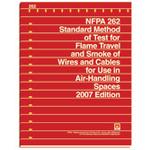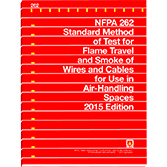
NFPA (Fire) 262
- Comments Off on NFPA (Fire) 262
- NFPA-FIRE
Product Details
- Published:
- 11/29/2022
- ISBN(s):
- 9781455929795
- ANSI:
- ANSI Approved
- Number of Pages:
- 39
- Note:
- This product is unavailable in Ukraine, Russia, Belarus





Click here to purchase
Improve fire safety using the 2019 edition of NFPA 262, Standard Method of Test for Flame Travel and Smoke of Wires and Cables for Use in Air-Handling Spaces to accurately measure and record flame travel distance and the optical density of smoke along cable and wires to confirm they meet certain requirements for being categorized as having low-smoke producing, fire-resistance characteristics. (Softbound, 35 pp., 2019)




Click here to purchase
NFPA 262: Standard Method of Test for Flame Travel and Smoke of Wires and Cables for Use in Air-Handling Spaces presents a test procedure to evaluate the potential for fire spread along cables and wires housed in a plenum or other environmental space. The methodology measures both flame travel distance and optical density of smoke.




NFPA 262 presents a test procedure for evaluating the potential for fire spread along cables and wires housed in a plenum or other environmental space.
It has been harmonized through a coordinated effort between NFPA, UL, and ASTM, and is accepted by UL as the replacement for UL 910: Standard for Safety Test for Flame-Propagation and Smoke-Density Values for Electrical and Optical-Fiber Cables Used in Spaces Transporting Environmental Air.
Originally developed by Underwriters Laboratories Inc. and published as UL 910, the Standard is an adaptation of the Steiner tunnel test (NFPA 255: Standard Method of Test of Surface Burning Characteristics of Burning Materials, ASTM E84: Standard Test Method for Surface Burning Characteristics of Building Materials, UL 723: Tests for Surface Burning Characteristics of Building Materials).




Click here to purchase
NFPA 262: Standard Method of Test for Flame Travel and Smoke of Wires and Cables for Use in Air-Handling Spaces presents a test procedure to evaluate the potential for fire spread along cables and wires housed in a plenum or other environmental space. The methodology measures both flame travel distance and optical density of smoke.



